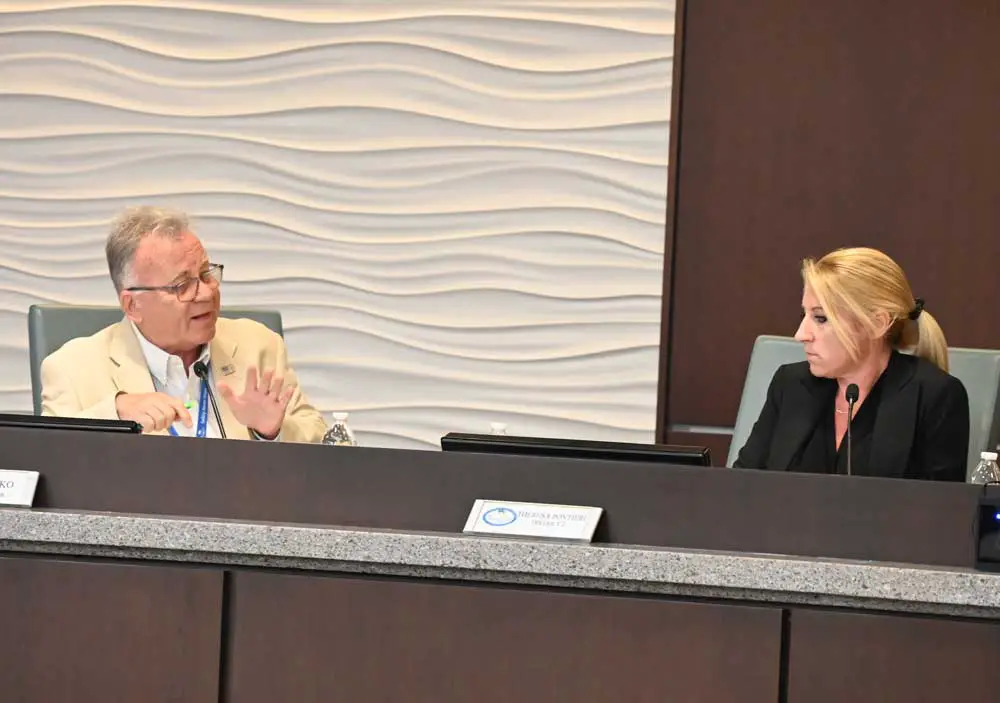
Joe Saviak had barely invited Palm Coast City Council members to list their objectives for the coming year, beginning with “Objective 1,” when Ed Danko pre-empted his colleagues with four words succinctly spoken, pausing between each for emphasis: “Full. Millage. Rate. Rollback.”
That started it.
Saviak is the management consultant the city hired to shepherd the council through what it call its “Strategic Action Plan”–what is more ordinarily known as the annual goal-setting session. He’d spent 35 minutes summarizing the numerous steps and reams of data and analysis he’d gathered in the process in the past few months, after interviewing council members and directors, holding a previous workshop with them, and surveying them.
One of the results was a list of 14 priorities the council members had listed as their own individual priorities or wishes. It was now time to draft the list that had the whole council’s consensus–what would, in effect, become the driving priorities and policies of the coming year.
Rollback in millage is when the property tax rate of the coming year is “rolled back” to the point where the government will not take in more money next year than it did this year. It is not a tax cut. Nor is it a tax increase. It should not be confused with keeping the tax rate the same. Most years, Palm Coast has kept its tax rate flat, but that has equated to a tax increase because as property values rise, so does tax revenue, if the tax rate is the same (or if it increases). The city has used the extra revenue to manage growth. By rolling back the tax rate, that extra revenue is eliminated. (See: “What is the Roll-Back Rate in Property Taxes?“)
More because of a political miscalculation than a concerted plan–though all council members took credit for it–the council last year ended up going to rollback for the first time in its history. (Following the housing crash and the Great Recession of 2008, the city did go up to rollback, as property values were plummeting, but only to ensure that its revenue did not fall too drastically.) Danko exulted: he’s made his name as an advocate of low taxes. But the city suffered a loss of nearly $3 million it had banked on in its original budget. Various plans, including road resurfacing, had to be shelved.
Danko, who is running for a County Commission seat, now wants to do it all over again. So he pushed for rollback.
Mayor David Alfin tried to delay that discussion, and for a few minutes the council members offered up other wished-for priorities without seeking consensus but Council member Theresa Pontieri decided to take up Danko’s proposal more immediately.
“I’m going to go a little more out on the ledge on this one and say we can’t afford a rollback, not a full rollback,” she said. “Not if we’re looking at the infrastructure needs of our city. When I listen to residents come before us and stand at that podium and for three minutes tell me about what they needed and want in their city, it’s not $30 in savings on their property tax bill. It is: I want you to fix roads. I want my swale not be flooded. When I put a case in Palm Coast Connect, I want to not wait two or three weeks for someone to come out.”
Pontieri said she was glad for last year’s rollback because it was “absolutely necessary” at the time, with rising prices. But the list of current priorities, both from council members and administrative directors, points to a different reality. “The main theme that seems to be pretty recurring and strong is, we don’t have enough money to fund the swale maintenance that we need to fund. We don’t have enough money to fund potable water wastewater. We don’t have enough money to fund road pavement. So I’m not opposed to figuring out how we get to full rollback. What I am opposed to it saying well, I want a full rollback and not coming up with a solution as to how we get there, without also addressing these other infrastructure needs.” (Swale maintenance is funded out of the city’s stormwater fund, separately from the general fund. The stormwater fund is fed by a monthly fee on residents’ utility bill. It is not affected by property taxes.)
She invited Danko to devise alternative funding methods for those priorities, then come back to council and propose them.
“I would totally disagree with that because the same reason you voted for a rollback last year, those situations still exist,” Danko said. “All you have to do is go put some gasoline in your car, go shopping at Publix or Walmart, everything has still gone through the roof.” Never wasting an opportunity to campaign, Danko then in the same breath bashed “Bideneconomics” and described knocking on doors as he campaigns, listening to people complain of high prices, “and why can’t we tighten our belts and do another full millage rate rollback because that small amount of money does add up, at least in their pocket books, especially for our senior citizens.”
In fact, a rolled back rate does not affect homesteaded property owners as much as it does non-homesteaded property owners, who are not protected by Florida’s Save Our Homes cap on property tax increases. Most homesteaded residents have not seen their city tax bill go up, and in inflation-adjusted dollars, they’ve seen it fall since the Great Crash. But it’s a different story for the non-homesteaded and for renters, who pay property taxes through their rent.
Danko said the city could, for example, contract out its swale maintenance. “I think first we set the budget goal, and then we find where we can make the cuts,” he said.
The sheriff’s office needs nine new deputies, Pontieri told him–money that would come out of the city’s general fund. “How do we get that money elsewhere?” she asked him.
Danko told her how not to get the money (he opposes a sales tax increase, for example) but did not say how to get it. Not yet, anyway. He said the city should look at the money it has, then budget accordingly. “If we’re motivated to find those cuts by setting that limit with a full millage rate rollback, I think we’ll be a little more successful,” he said.
Mayor David Alfin was uncomfortable with setting down either proposition as final. “You have to approach it from both sides,” he said. “If you start just on one side and you arbitrarily choose a budget finish line, you may not properly prioritize the issues that the public has brought forward.”
Danko conceded: he wasn’t asking for the rollback rate to be adopted today. He was asking for that to be a goal, even if it’s not necessarily achieved in he end. “The point is to set the goals and if we can accomplish them, we do accomplish them,” he said. That approach was amenable to his colleagues–up to a point. Council member Cathy Heighter called it a “challenge,” and Nick Klufas said it’ll inevitably become increasingly difficult to find ways to cut the city budget, with demands being what they are, after last year’s cuts.
So the proposal was logged in as a priority on what became a list of 12 such priorities for the year: the council will seek to identify alternative revenue sources and identify savings.
With a caution from Pontieri: “We can’t just cut again and call it a day. There’s got to be a way to get there.”










